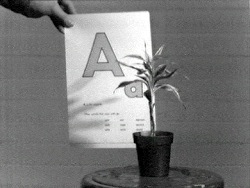John Baldessari
Biography
A major figure in contemporary art, John Baldessari has been termed "one of the most influential artists to emerge since the mid-1960s." Baldessari worked in a range of mediums including artist books, videos, films, billboards and public works. From his phototext canvases of the 1960s to his composite photo collages and installations of the 1980s, Baldessari has contributed to the definition of postmodern art. His ingenious application of certain art-making strategies — including appropriation, deconstruction, decontextualization, sequentiality and text/image juxtaposition — was prescient, as was his cogent and witty integration of semiology, linguistic systems and mass media.
As one of the seminal figures in the language-based Conceptual Art movement of the early 1970s, Baldessari produced a series of videotapes in which he conducted ironic investigations into perception, meaning and interpretation. Rendered with deadpan, often absurdist humor, these droll conceptual exercises make use of cultural artifacts, from film stills and magazine photos to art historical in-jokes, as frameworks for irreverent philosophical inquiries into art and knowledge. With a cunning reliance on misrecognition and misinformation, Baldessari used irony and incongruity to exploit the gap between what is heard, what is seen, and what is understood. His wry investigations of representation and sign systems succeed through strategies such as the ironic juxtaposition of photographic or video images and written or verbal texts; the use of appropriated material and found objects to underscore the embedded meaning of pop cultural genres; the construction of disjunctive narratives and surreal conjunctions from re-contextualized words and images, and the indexing of objects of actions.
Many of his exercises take the form of parables, allegories, or "art lessons," as Baldessari the performer assumes the role of teacher or storyteller. His fascination with jokes, dreams, aphorisms, sight gags and linguistic pranks, which are linked to Freudian notions of unconscious associations and verbal and written "slips," evoke the visual puns and word games of Dada and Surrealism. Pervaded with reference to art-making and art history, and responding to the tenets of minimalism, performance and Conceptual Art, his tapes question the very limits of art, and form an irreverent critique of modernist practices. Baldessari playfully compels the viewer to question not only the system under investigation — language, representation, narrative, art-making — but also the tools by which the interrogation is being conducted (photography, video, cinema) as conveyers of truth. Ultimately, Baldessari's idiosyncratic, often absurdist logic questions the very process of perception, from vision and meaning to cognition and knowledge.
Baldessari was born in 1931 in National City, California, and died in 2020. He received a B.A. and an M.A. from San Diego State University, and also studied at U.C. Berkeley, UCLA, Otis Art Institute and Chouinard Art Institute. He was awarded an Honorary Doctorate from San Diego State University in 2003, and in 2004 was elected to the American Academy of Arts and Sciences. The recipient of a Guggenheim Fellowship in 1986 and grants from the National Endowment for the Arts, he was also awarded the Oskar Kokoschka Prize, the California Governor's Award for Lifetime Achievement in the Visual Arts, the Americans for the Arts Lifetime Achievement Award, the Golden Lion for Lifetime Achievement awarded by La Biennale di Venezia and the City of Goslar Kaiserring in 2012, the National Medal of Arts Award in 2014, and an award from the International Print Center New York in 2016. He has taught at Southwestern University, California; the University of California at San Diego; and the California Institute of the Arts, Valencia. He has received honorary degrees from the National University of Ireland, San Diego State University, Otis Art Institute of Parsons School of Design, and California College of the Arts.
His work has been exhibited internationally in one person shows at the Stedelijk Museum, Amsterdam; Sonnabend Gallery, New York; Museum Folkwang, Essen, Germany; Contemporary Arts Museum, Houston; Santa Barbara Museum of Art, California, and Museo Nacional Centro de Arte Reina Sofía, Madrid, among other institutions; and in group shows at the Contemporary Arts Museum, Houston; Documentas 4,5 and 6, Kassel, Germany; Venice Bienale; Palais des Beaux Arts, Brussels; Everson Museum of Art, Syracuse; The Museum of Modern Art, New York; Kolnischer Kunstverein, Cologne; and the Whitney Museum of American Art Biennial, New York, among others. More recent exhibitions include an exhibition at the Garage Center of Contemporary Culture Moscow in 2013, Stadel Museum, Frankfurt in 2015, Marian Goodman Gallery London in 2015 and Spruth Magers Gallery Los Angeles in 2016.
In 1990, he was the subject of a major retrospective at the Museum of Contemporary Art, Los Angeles, which traveled to numerous sites around the country. In conjunction with this exhibition, a comprehensive catalogue of his work, entitled John Baldessari, was published in 1990.
In 2009, his retrospective exhibition John Baldessari: Pure Beauty opened at the Tate Modern in London. It traveled to the Los Angeles County Museum of Art, Los Angeles, and the Metropolitan Museum of Art, New York, in 2010. In 2011 it travelled to Museu d'Art Contemporani de Barcelona, Spain. The retrospective includes a catalogue publication, also entitled Pure Beauty.
Baldessari lived in Santa Monica, California, until his death in 2020.
